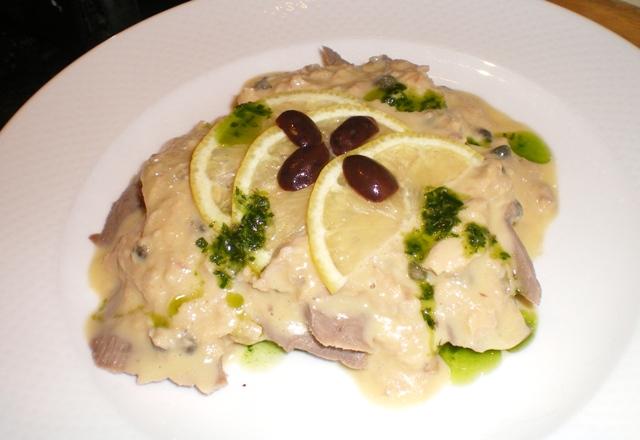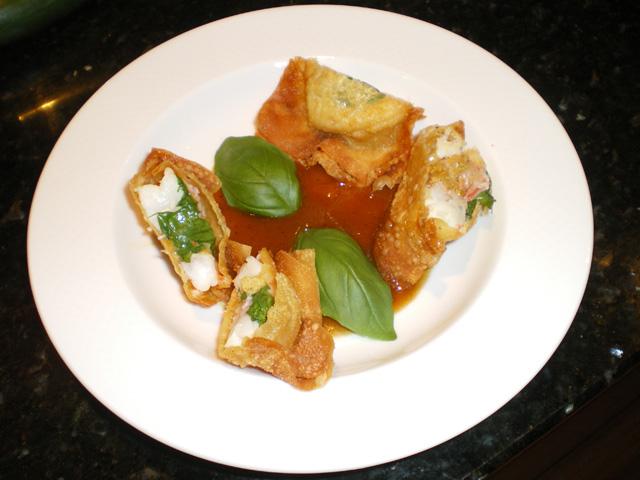-
Posts
2,606 -
Joined
-
Last visited
Content Type
Profiles
Forums
Store
Help Articles
Everything posted by nickrey
-
Kim that winter food looks lovely. With 81F heat and 72% humidity, however, I think I'll just have to go back to my cold meat and salads.
-
For the basil, it keeps better frozen when it is made into pesto but I suspect this may not help your Thai food. Another alternative is to pickle it in brine. Check a recipe for pickled (brined) vegetables and adapt that for your basil. The only problem is that while it should retain the colour, it is going to markedly change the flavour profile.
-
When storing curry paste in the refrigerator (or ice cream in the freezer for that matter), it is best not to let air come into contact with the food. Take some kitchen plastic wrap and press it flat on the surface of the paste. This will extend its life and help retain volatile fragrances.
-
It is "strozzapreti" or "priest chokers," which comes from Emilia-Romagna. Legend has it that some priests when visiting had a reputation as gluttons and the pasta was of such a shape that it would "choke the priest" given his eating habits.
-

Infusions, Extractions & Tinctures at Home: The Topic (Part 1)
nickrey replied to a topic in Spirits & Cocktails
Japanese? Try infusing/mixing vodka with the following: mirin teriyaki sauce rice wine/sake wasabi finely chopped ginger -
Dinner tonight was Vitello Tonnato (base recipe courtesy of Marcella Hazan). Cooked veal escalopes sous vide at 57 degrees. Chilled in ice-bath and kept in refigerator. Dressing was home-made mayonnaise, half extra virgin olive oil, half grapeseed oil. This was combined with anchovies, rinsed salted baby capers and lemon juice to taste. The dressing was also refrigerated. Garnished with slices of lemon, slices of olive and parsley oil.
-
Most of the cocktails I've come across are pretty global in nature. You could be sitting anywhere in the world to enjoy them. Someone mentioned Bundaberg rum above, and I'm sure this could be used in a rum-based cocktail that would not taste anything like what you would get in the rest of the world. Also as mentioned above, we have some lovely wines that could be used in wine based cocktails. I'm think in particular of something using the very Australian sparkling red wines (think champagne made with red shiraz grapes). We also have some strong tasting fortified wines (made from muscat or tokay grapes), which could be used in cocktails typically using sherry or port.
-
Wagyu comes with its own in-built fat storage. You shouldn't oil the pan as this could intefere with the natural taste. Make sure you bring the meat up to room temperature before cooking it. Don't overcook. You want to cook and retain the internal fat, not melt it away. Aim for medium at the most. Also, I wouldn't recommend undercooking thicker steaks: the fat in the middle doesn't cook properly, creating a less than pleasant eating experience. If it's very, very thinly sliced, it could have been cut for Shabu Shabu. In this case, you can cook it by dredging it backwards and forwards in a pot of simmering dashi stock (think Japanese fondue). Then use a ponzu or sesame dipping sauce.
-
If you want to taste the difference that can be seen in a single terroir chocolate, check out Chuao chocolate by Amedei. There is an article here about the chocolate and its makers. It makes for interesting reading.
-
Victorinox (the people who make the Swiss Army knife) make a wide range of very good slicing and filleting knives. Here's a link to their salmon slicing knife. As a number of people have said or alluded to, the secret to slicing any meat such as this is similar to that of slicing sushi. You need to use a single slice with the whole knife. Once you start sawing, you will fracture the meat. Start off at the heel and work your way as you slice through to the tip. For this reason, you need something long (around 30 cm/12 inches).
-
After frying I always use a paper filter for my oil. When opened up they are cone-shaped and fit into a large funnel sitting directly in the oil bottle. It takes a while for the oil to run through but I find I can use the oil many times before replacing it. Jeff, if your oil smells at all like fish, I wouldn't use it for anything other than fish and chips.
-
You mentioned oil droplets. You can use them to enliven both presentation and taste. Check out this dish that I did. The green oil droplets in the sauce are parsley oil. To achieve it, get a quantity of parsley. Freeze dry it in your freezer. Put it into a food processor and process until powdered (the freezing makes this step possible). Add to oil. In this case as it was going with fish, some salted capers were rinsed and drained, freeze dried and processed with the parsley. I used an eye dropper to place the oil in the sauce. This process gives colour in terms of plating and also flavour.
-
One of our Australian cooking magazines, Gourmet Traveller, asked 60 top chefs what their recipe was for Bolognese. The article is here.
-
I have used Antony and Araminta Hippisley Coxe's Book of Sausages as a reference to see what is in various sausages before going on to create my own versions. Having read the savage Amazon critiques, however, I feel compelled to add: Don't buy this book if you: 1. want recipes with exact quantities of everything 2. are expecting sources for American suppliers 3. are turned off by a British author having the temerity to slant their book towards UK content and terminology Otherwise with these shortcomings, it is a good source book to see what goes into various sausages from around the world that you may have come across. Charcuterie also involves making products not encased in skin. I also use the Time-Life book on Terrines, Pates and Galatines which has good pictorial guides to producing many classic dishes. As an on-line resource (not a book but, hey, we're new media savvy), check out Len Poli's sausage recipes on this web site. He also lists a number of books on sausage making on his resources page.
-
For me the knife is a necessity. I think I've snapped the handles of around 10 garlic presses. My dirty little secret is that I sometimes use ready made crushed ginger and crushed chili.
-
Our dinner tonight was unashamedly (slightly) adapted from one of the sous vide videos by the chef at Eleven Madison Park (see here). Sous vide salmon with stuffed zucchini flowers and red capsicum hollandaise.
-
The potato starch that I buy in Sydney is Japanese in origin. As outlined above it's name is Katkuriko. In my case the company producing it is the Hokuren corporation. I typically use it for thickening sauces instead of cornstarch. You use less potato starch for an equivalent amount of liquid than flour, it is tasteless, gluten free, and more translucent than corn starch. Add it at the end of cooking as a slurry mixed with water (to a thin cream like consistency). It thickens at a lower temperature than cornstarch so you will need to watch the sauce carefully so as to remove it from the heat when it is sufficiently thickened. Thanks for the information on using it in batters, I'll try it out.
-
The information that I have is that there are two different strengths of tea. The first is called Usacha, which is a weaker version that is popular, this is made with 2 chashaku (1/2 level teaspoon) to 75 ml of water (below boiling [85 - 95 degrees celsius]). The second is the one used in the tea ceremony, Koicha, which is stronger. This uses 4 chashaku (1 level tsp) of matcha to around 55 ml of hot water. Sorry about only using metric but it's all I've got.
-
Will do. But the post is still relevant to the discussion, it seems that the white charcoal is the one that is used for purifying foods.
-
I suspect you are talking about white charcoal. This link discusses the differences between them. The shiro-zumi (white charcoal) is much more dense than normal charcoal. When you clink two pieces together, it gives a stone like sound, so much so that you think the wood may be petrified. There are many claims for its health benefits but I suspect we are more interested in its cooking properties. It is meant to give a very good flavour to barbequed foods such as yakitori. I have seen it at a Japanese foods and knives supplier here in Sydney and am planning to use some in an hibachi to do some yakitori and other grilled meals in the very near future.
-
No, you'd need 96.37% curing salt 1 and 3.63% sodium nitrate. The way you're proposing gives 100% curing salt 1 plus 3.63% sodium nitrate (making it 3.5% sodium nitrate in the final mix). If you take the weight of curing salt 1 as 100, you'd need to add 3.77 of sodium nitrate to achieve your aim. This makes the total weight 103.77 with 3.63% of that being sodium nitrate.
-
Salt the onions prior to cooking and you will get an increased caramelizing effect. Martin Lersh at Khymos, also recommends adding a pinch of bicarbonate of soda (baking soda) to increase the onions' alkilinity as an accelerant to obtaining Maillard browning. His article is here.
-
It is my understanding that atomisers are used to intensify experiences in what has been termed techno-emotional cuisine. Similar to Heston Blumenthal's use of headphones playing ocean sounds for his sounds of the sea, it is a means of evoking an emotional connection that heightens the diner's experience. One could imagine a forest-themed dinner (all earthy flavours; mushrooms, truffles, with game for example), presented with some pine or oak essence in an attempt to get people to have a sense of location. Accompany this with forest sounds and you'd almost have an immersive experience. My suggestion would be to choose a theme and integrate the other senses with it. Sight, sound, taste, touch, and smell could all come into play. In hypnosis you evoke strong memories and sense of place by having the person immerse themselves in a scene by evoking many of the senses. You are trying to do a similar thing (without the spinning watch). One piece of advice though: if you go too far, natural cynicism could kill the mood. Now off to try the atomiser of Noilly Prat...
-
If you want to clarify the cider, I'd recommend trying isinglass finings. These are used for traditionally conditioned ales and would be a worthy, but not necessarily vegetarian, substitute for the old pig's blood method.
-
I did a masterclass the other day with Nicolas le Bec. Wanted to let my wife try the product that evening and also to cook it while it was fresh in my mind. Prawn Ravioli with a sauce from the shells: Poached Atlantic Salmon in Cider Jus with Apple and Cucumber Tartare:





